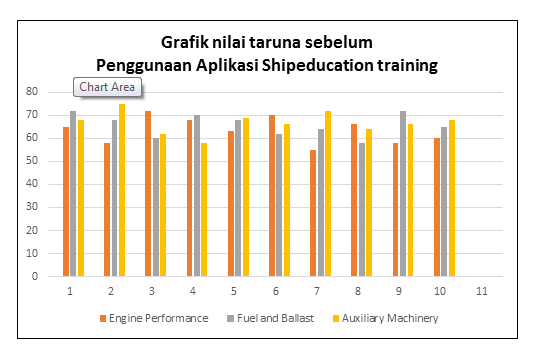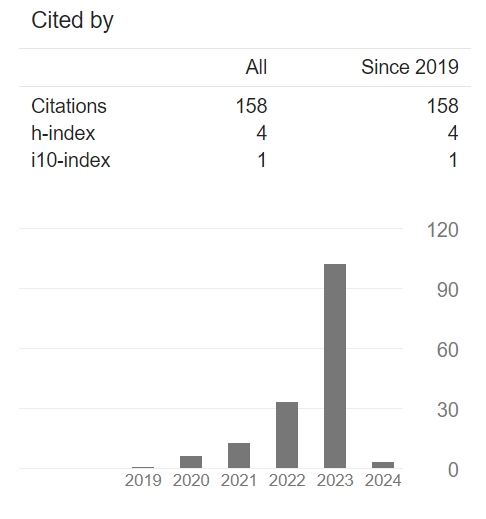THE ROLE OF USING THE SHIPEDUCATION TRAINING APPLICATION TO IMPROVE THE RESULTS OF THE SEAFARING SKILLS EXAM FOR SHIP ENGINEERING TECHNOLOGY CADETS OF THE VOCATIONAL FACULTY OF SAILING, HANG TUAH UNIVERSITY
DOI:
https://doi.org/10.62012/sensistek.v6i2.28468Keywords:
Kata Kunci: Aplikasi ShipEducation Training, Hasil ujian keahlian, Pendidikan maritim, Teknologi pendidikanAbstract
This research investigates the influence of the ShipEducation Training Application on the test results of maritime cadets' skills in the Marine Engineering Technology Program, Faculty of Maritime Vocational Studies, Hang Tuah University. The main objective of the research is to analyze the impact of using this application on the understanding, skills, and test results of maritime cadets' skills. This study involves 150 respondents who use the ShipEducation Training Application in the learning process. Data analysis methods include descriptive statistics, correlation analysis, and linear regression. The research results indicate that the use of this application has a positive impact on the understanding and skills of maritime cadets. The average test results of active maritime cadets using the application reach 85%, while those who are not active only achieve 72%. Regression analysis shows a significant relationship between the frequency of using the ShipEducation Training Application and the skill test results, with a correlation coefficient of 0.67. Learning motivation factors also significantly influence test results. The findings of this research imply the importance of implementing educational technology in maritime education. In this context, the recommended actions include optimizing the promotion and training related to the ShipEducation Training Application for maritime cadets. The integration of technology into the curriculum also needs to be strengthened to support more adaptive and effective learning. Moreover, educational institutions need to encourage student learning motivation so that they become more active in using the application during the learning process. In conclusion, the ShipEducation Training Application plays a crucial role in enhancing the test results of maritime cadets' skills. By implementing the proposed recommendations, it is expected that the utilization of educational technology can be more optimal in preparing maritime cadets to meet the demands of the shipping industry. Keywords: ShipEducation Training Application, skill test results, maritime education, educational technology.Downloads
References
IMO Model Course 7.04: Officer in Charge of an Engineering Watch, 2014 Edition Standard of Training Certification and Watchkeeping for Seaferers, Including 2010 Manila Amandements, STCW Convention and STCW Code
Ahmad, I. (2018). Pendidikan Tinggi" 4.0" yang Mampu Meningkatkan Daya Saing Bangsa. Makassar, Indonesia.
Awedh, M., Mueen, A., Zafar, B., & Manzoor, U. (2015). Using Shipeducation and Smartphones for The Support of Collaborative Learning. ArXiv Preprint ArXiv:1501.01276.
Dervan, P. (2014). Increasing in-Class Student Engagement Using Shipeducation (an Online Student Response System). AISHE-J: The All Ireland Journal of Teaching and Learning in Higher Education, 6(3). UU No. 20 Tahun 2003 tentang Sistem Pendidikan Nasional.
Zulkiflirubekmeupayong,TataCaraPenggunaanAplikasiShipeducation,https://id.scribd.com/presentation/427219350/Tata-Cara-Penggunaan-Aplikasi-ShipeducationBudiman, H. (2017). Peran teknologi informasi dan komunikasi dalam pendidikan. Al- Tadzkiyyah: Jurnal Pendidikan Islam, 8(1), 31–43.
Du, J., van Koningsbruggen, G. M., & Kerkhof, P. (2018). A brief measure of social media self-control failure. Computers in Human Behavior, 84, 68–75.
Lysenko, L., Abrami, P. C., Wade, C. A., Marsh, J. P., WaGioko, M., & Kiforo, E. (2019). Promoting young Kenyans’ growth in literacy with educational technology: A tale of two years of implementation. International Journal of Educational Research, 95, 176–189. https://doi.org/https://doi.org/10.1016/j.ijer.2019.02.013
Rohaeti, E. E., Bernard, M., & Primandhika, R. B. (2019). Developing Interactive Learning Media for School Level Mathematics through Open-Ended Approach Aided by Visual Basic Application for Excel. Journal on Mathematics Education, 10(1), 59–68.
Palippui, H., and T. Pairunan. "Ship building design of general cargo vessel using comparator ship method in port route of Jakarta-Makassar-Manokwari." In IOP Conference Series: Earth and Environmental Science, vol. 921, no. 1, p. 012035. IOP Publishing, 2021.
Singhato, A., Banjong, O., & Charoonruk, G. (2017). Effectiveness and acceptance of the developed educational media on the application of a Thai ethnic snack, Thong Pub, with calcium fortification. Journal of Ethnic Foods, 4(1), 58–63. https://doi.org/https://doi.org/10.1016/j.jef.2017.02.007
Vu, T. L. A., & Le, T. Q. (2019). Development orientation for higher education training programme of mechanical engineering in industrial revolution 4.0: A perspective in Vietnam. Journal of Mechanical Engineering Research & Developments (JMERD), 42(1), 71–73.
IMO (International Maritime Organization). (2010). International Convention on Standards of Training, Certification and Watchkeeping for Seafarers (STCW). London, UK: IMO.
Maier, J. F. (2016). Human Factors in Ships: Concepts and Definitions. In J. F. Maier, K. Sames, & D. J. Frost (Eds.), Human Factors in Ships (pp. 3-12). Springer.
Wong, K. W., Wong, K. L., Fung, C. C., & Li, J. (2009). Developing Mobile Learning Applications in Maritime Education and Training. Journal of Interactive Learning Research, 20(1), 59-76.
I. J. Caecielia and N. D. Tuharea, “Analisys of Hull Shape Art, Speed, Resistance, Power Using Holtrop Method On A Vessel With DWT 12,335 Ton”, Journal of Maritime Technology and Society, vol. 1, no. 3, pp. 87-92, Oct. 2022.
World Maritime University (WMU). (2021). Ship Education Training: Modernizing Maritime Training through Gamification. Retrieved from https://www.wmu.se/news/ship-education-training-modernizing-maritime-training-through-gamification
Smith, J. (2021). The Impact of Climate Change on Marine Biodiversity. Marine Conservation Society. https://www.marineconservation.org/climate-change-marine-biodiversity
Susanto, A. (2019). Implementasi Aplikasi Ship Education Training dalam Pendidikan Pelaut: Studi Kasus Prodi Teknologi Rekayasa Permesinan Kapal, Fakultas Vokasi Pelayaran, Universitas Hang Tuah.
S. Klara, S. Hariyanto, F. Mahmuddin, and P. Shantya, “Maintenance Design of The Main Engine Support Systems on KMP. Kormomolin Under System Dynamics Scheme”, Journal of Maritime Technology and Society, vol. 2, no. 2, pp. 46-54, Jun. 2023.
M. H. Ba Naga, “Comparative Analysis of Faired-In Bulb and Bulbous Bow Ram Bow’s Bulbous Bow Shape On Total Ship Resistance”, Journal of Maritime Technology and Society, vol. 2, no. 1, pp. 28-30, Feb. 2023.
A. Alamsyah, “The Analysis of Engine Room Vibration of Tugboat 24 M”, Journal of Maritime Technology and Society, vol. 1, no. 3, pp. 93-101, Oct. 2022.












